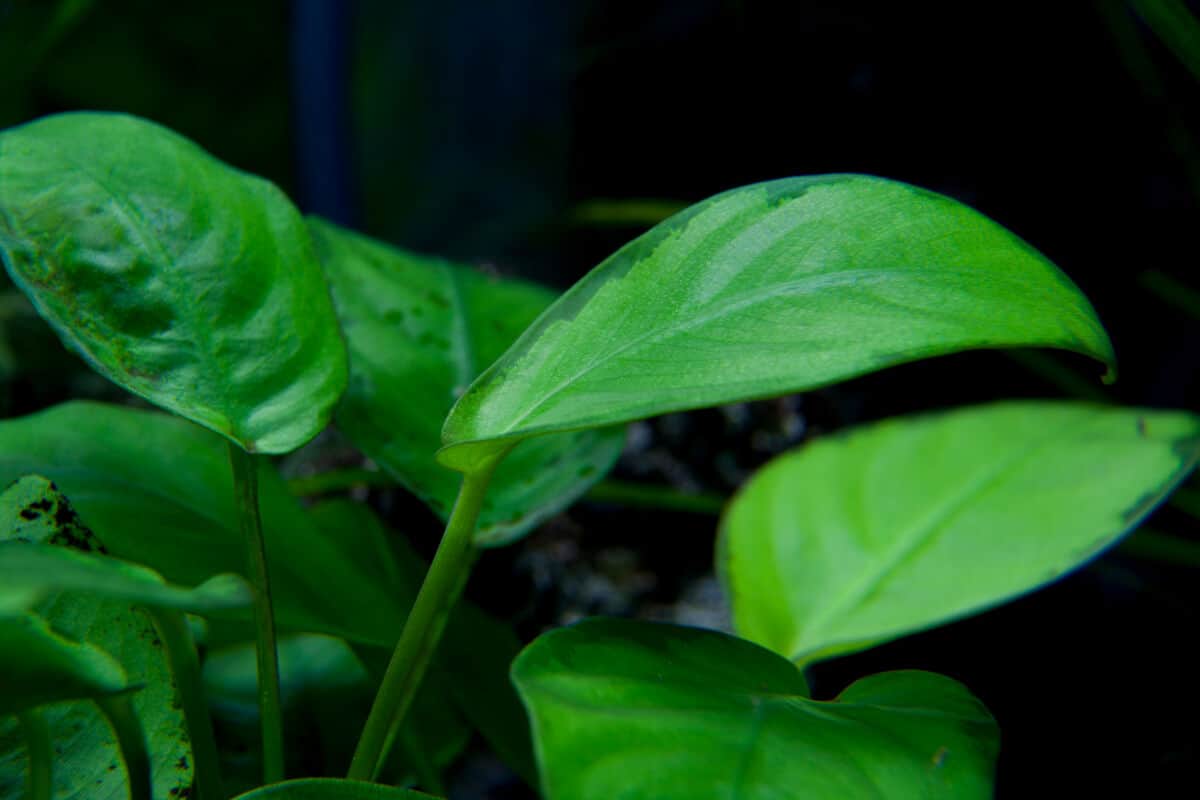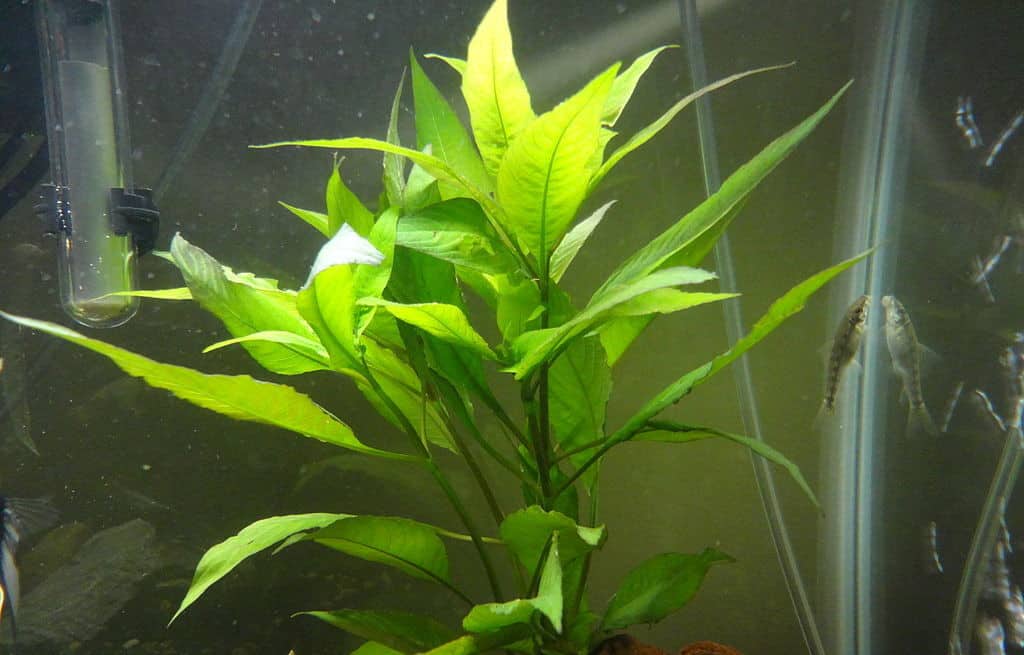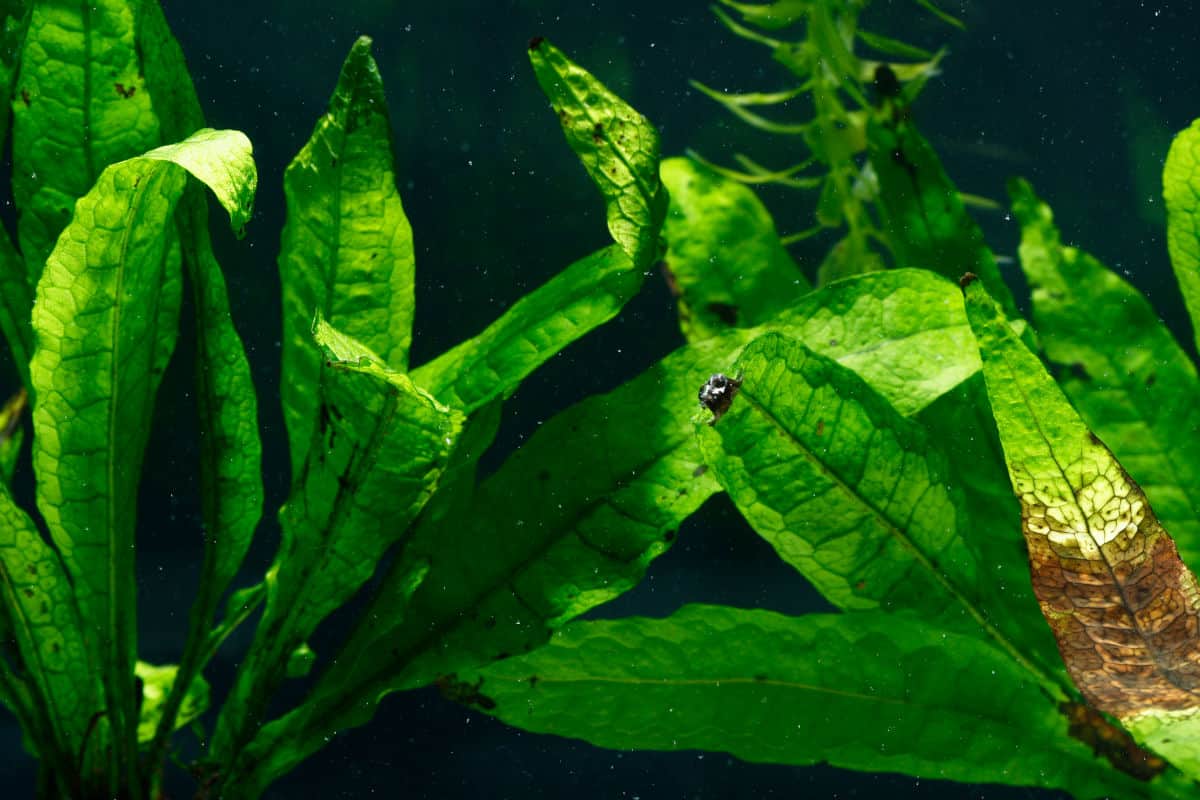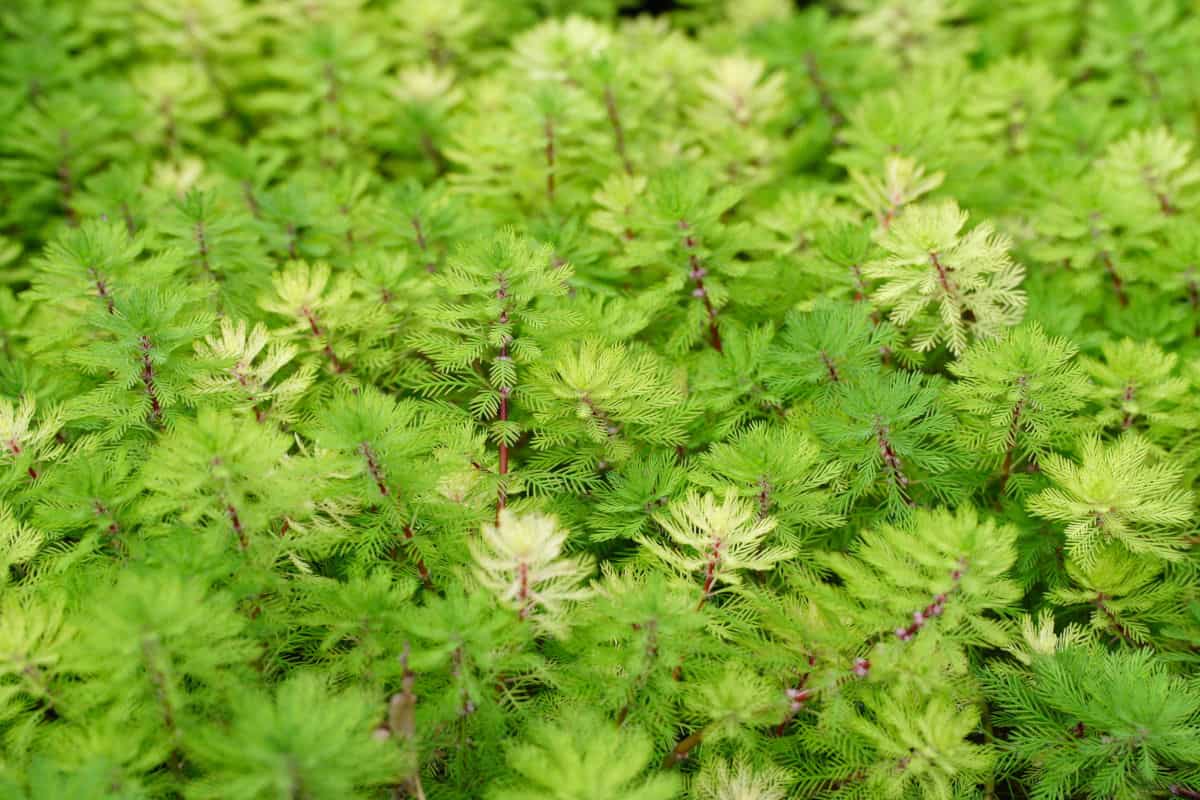Have you recently purchased an aquarium and are looking to fill up some empty space with a strong, easy-to-maintain plant? If so, Anubias nana care is super simple, so it just might be the plant you’re looking for.
Anubias nana is a freshwater, semi-aquatic variety within the Anubias barteri family. It’s very hardy and can survive any tough experience a beginner aquarist might subject it to! It doesn’t require much light and can be easily grown indoors.
Your fish will find comfort hiding within its broad leaves. It thrives in most water conditions and even without substrate. This makes it one of the most popular water plants for aquariums.
In this article, we take a really deep dive look at Anubias Nana. We look at it’s profile, how to buy healthy plants, how to care for them, what tank setup suits them and tank mate compatibility.
By the end of this guide, you will have a good idea whether it’s really for you and whether it will fit into your planted tank plans.
Overview and Statistics
Compact and attractive, Anubias nana makes a nice addition to any aquarium, adding a splash of bold green color. Ready to learn more about them and their care? Let’s start with the basics.
| Characteristic | Details |
|---|---|
| Common name(s): | Dwarf Anubias, Anubias nana, nana. |
| Scientific Name(s): | Anubias barteri var. nana. |
| Family: | Araceae. |
| Origin: | West Africa. |
| Color Form: | Green |
| Maximum Size: | 8 inches |
| Growth Rate: | Slow |
| Care Level: | Easy |
| Water Conditions: | Freshwater, 72-82° F, KH 3-8, pH 6.0-7.5. |
| Lighting: | Moderate |
| Minimum Tank Size: | Any size or shape. |
| Supplements: | CO2 fertilization, substrate fertilizer. |
| Placement: | Foreground. |
| Propagation: | Rhizome division. |
| Tank mates / Compatibility: | Gets along well with most fish and other water plants. |
The species was first mentioned in 1857 by Heinrich Wilhelm Schot. It was found growing along riverbanks in Western Africa—more specifically Cameroon and Nigeria. Many Anubias plants have since been discovered, Anubias nana is one of them.
Don’t mix the nana variety with Anubias ‘gold’ as that species needs to be moved to a larger environment as it matures. There’s also Anubias ‘petite,’ which is the dwarf version of nana and won’t grow taller than two inches.
Anubias nana is now found across Europe, Asia, and the United States. In the wild, it’s mostly found in forests and is rarely submerged entirely.
What Does Anubias Nana Look Like?
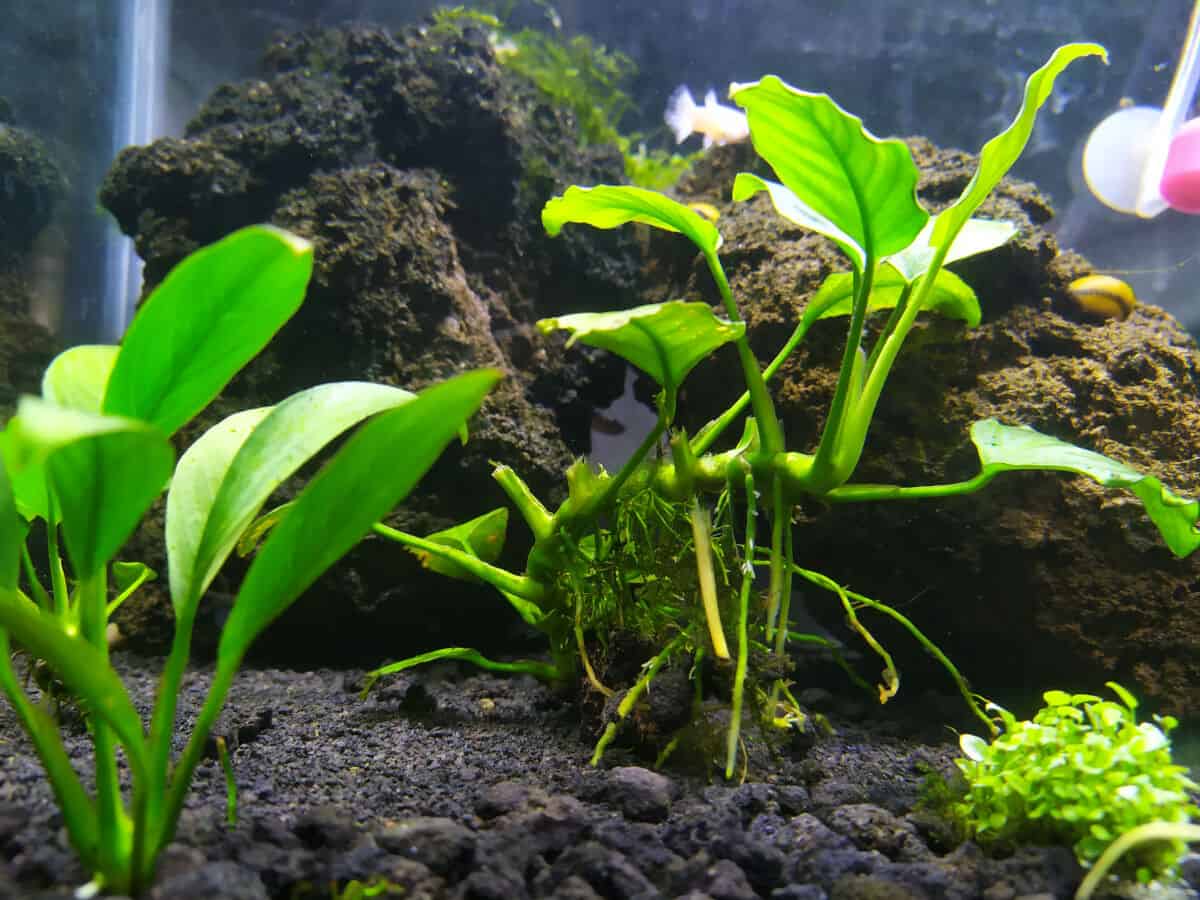
It stands out, with its leather-like, durable leaves. Each dark green leaf can grow up to two and a half inches long and just over an inch wide. A short plant with broad leaves, it is a favorite among hobbyists.
The plant itself is one of the smallest Anubias varieties, averaging a height between two and four inches, the rhizome itself ranges from four to six inches high.
The wide, oval leaves usually grow in low clumps and branch off the stem in a teardrop shape. Each leaf is covered with a cuticle and shows a larger vein running vertically through its center.
The white roots will keep the plant attached to the bottom of your aquarium, whether in the substrate or attached to a rock.
It can produce white flowers even when fully submerged. The flowers will bloom for about two to three months and create a beautiful visual arrangement.
Where to Place it in a Tank?
Because it’s relatively small, it can be easily placed in the foreground of your tank. Larger or more mature plants can be used as a mid-ground plant or even as a focal point.
It doesn’t do well as a floating plant and is better planted or attached to driftwood or rock. Attaching it gives you the flexibility to choose the exact location and helps you with aquascaping your aquarium.
Because it’s slow-growing, you won’t have to worry about overcrowding your tank, any small empty space will do the trick!
Benefits of Introducing Anubias Nana to Your Aquarium
Introducing Anubias nana will help you shape your aquarium exactly as you need. Just as it needs shade to grow healthily, when it’s grown up, its large leaves provide shade for other low-light species beneath it.
It is not only decorative. It also provides a habitat for other fish; a place to feed, hide, and lay their eggs.
By keeping the nitrate levels under control, oxygenating the water, and removing potential pollutants, Anubias nana acts as a water filter to keep your ecosystem healthy and balanced.
Preferred Habitat
Although it can thrive in many different living conditions, here are some tips to help increase the plant’s lifespan and growth.
Minimum Size Tank Required
As long as you have an aquarium – of almost any size – you should be able to grow Anubias nana. It doesn’t require a large volume of water.
In the wild, it lives alongside river banks and in shallow waters either partially or entirely submerged. A standard 10-gallon aquarium will provide plenty of space for it to grow and thrive.
Because it doesn’t enjoy direct light much, it’s important to plan forward and allow enough space for floating plants to grow. These create shade for Anubias nana to hide under.
Water Conditions
It is a freshwater plant and prefers warmer temperatures, between 72 and 82 degrees Fahrenheit. In winter, a fish tank heater can be used to maintain the water’s temperature.
Although itwill grow in most water conditions and is very tolerant when it comes to acidity levels, it does best in slightly acidic water, with a pH between 6 and 7.5, and a 3-8 KH. Because it grows slowly and steadily, it won’t require as many nutrients as some other aquatic plants do.
In the wild, it grows in running waters, such as streams and rivers, but can also tolerate standing water. it can even tolerate brackish waters up to 1.005 ppm. Good news if you’re looking to add some salt-loving fish to your aquarium!
Lighting Requirements
It is a very low maintenance plant when it comes to lighting. It can survive in low, medium, and in high levels of light. The less light, however, the slower the growth will be. Remember that it likes some shade, so aim for diffused light.
Placing a desk lamp eight inches above your aquarium and having it on for six to eight hours a day will be sufficient to keep it happy.
Avoid placing your tank in direct sunlight. Not only will the high light exposure encourage algae growth, but heat will also build up and overheat the water. This can create a greenhouse effect, and the plant’s leaves could bleach and turn yellow.
Substrate Requirements
The plant’s natural environment is easy to reproduce in your aquarium. The substrate should be soft and either muddy or fine-grained—such as sand. This allows the roots to grow, anchor, and take in nutrients from the environment.
This type of substrate is also less likely to damage the fine and delicate roots.
The substrate should be at approx. half an inch deep. Too shallow and it won’t be anchored properly. Deeper than half an inch, the substrate is liable to collect debris and damage the roots.
As ita grows slowly, it isn’t very demanding in terms of nutrients, but the occasional addition of fertilizer will benefit it, as it would any plant.
Anubias Nana Growth Rate
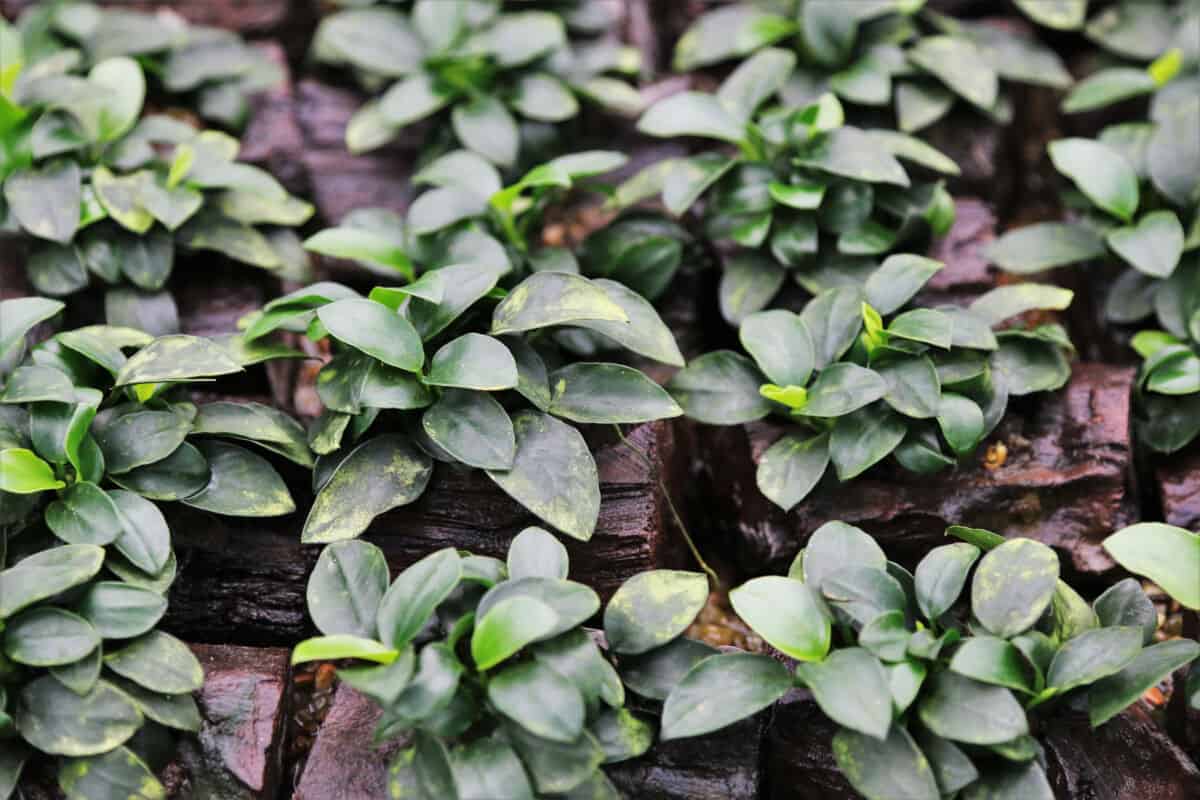
It is a slow-grower and can take a full year to grow to its full size.
It usually produces new leaves every three weeks, with each plant able to live for several years. It usually grows better emersed with the leaves above the water surface.
Care Advice
Anubias nana is one of the easiest plants to maintain. Because it’s a slow-growing species, it only needs to be pruned occasionally when the stems get too long.
Nutrients are stored in the roots, so don’t be shy to trim very close to the rhizome and remove any dead leaves. A section of the rhizome containing at least a few leaves can even be cut and then replanted where needed.
In order to control the nitrate levels in your fish tank, replace the water every few weeks. Clean water will improve light penetration, photosynthesis, and stop toxins and pollutants from building up and harming your aquarium’s ecosystem.
Nutrients can be added to encourage the plant’s growth. However, fertilizers will also encourage algae growth in your tank, especially beard algae. To avoid algae development on the leaves, it’s important to place it in a shaded area of your tank.
Although they can live solely on the CO2 provided by the fish in your aquarium, CO2 enrichment can help with photosynthesis and to stay healthy. Be mindful when adding carbon dioxide as too much can harm your fish.
It can also be grown both under and above the water’s surface. When switching it from an emersed to a submerged environment, it might have some difficulties adapting and shed a lot of leaves. If you’ve bought a plant that was grown emersed, don’t worry, new leaves should appear after the initial shed.
Buying Advice
How can you ensure you’re buying a healthy plant? Here are a few tips to bear in mind when you’re when shopping for Anubias nana.
Look for a strong stem able to support its own weight. We know it’s leaves are strong and large, therefore they require support. The leaves should be dark green in color. Stay away from any specimens with yellow or brown patchy leaves.
Do a quick visual check and look for cracked or damaged leaves. These will limit photosynthesis and slow down growth. Avoid purchasing a plant that already has visible algae growing on the leaves and look for a thick rhizome with healthy roots.
You’ll find Anubias nana sold in several different ways: as a bare root plant, displayed in a small plastic container, and already attached to a lava rock, driftwood, or a regular rock. If you’re planning to attach it, this may save you a lot of time!
It is a popular species, readily available in most pet or aquarium stores, and can even be purchased online. Its popularity makes it also very affordable. Prices range from $5 for a loose branch with a few leaves to $15 for a mature specimen sold in a plastic container.
How to add it to Your Tank
Because it absorbs nutrients through its leaves, it is great if you aren’t planning to add substrate to your tank. It grows better when its roots and rhizome are left exposed, rather than planted.
You can purchase the plant already attached to a rock, however, you can easily attach it yourself. Below we’ve listed the steps to take if you’d like to do this.
Most people use cotton or a fine fishing line. The benefit to a cotton thread is that it will naturally dissolve over time and won’t need to be manually removed. You’ll find the roots fully attached within a few weeks, after which you’ll have a hard time separating the roots from the rock.
Here’s how to attach your Anubias nana plant.
- Cut the roots: It can sometimes grow very long roots, don’t hesitate to cut them if they’re too long. The roots are very hardy and will grow again.
- Make two plants out of one: Cut the rhizome all the way through—a section that doesn’t have anything growing on it—to separate your Anubias nana into two smaller plants.
- Encourage growth: With a knife, make small incisions in the rhizome; every cut will encourage growth.
- Attach the plant: Using glue, a cotton thread, or a tie, attach it to a rock or a piece of wood.
- You’re done! You can now place it—along with the rock or driftwood— inside your aquarium at your desired spot!
If you’re looking to plant Anubias nana into your aquarium’s substrate, it’s best not to cover the rhizome, as it might rot and die. A soft substrate such as sand or fine-grained gravel is best.
Even though it grows slowly, it’s recommended that you leave at least two inches between each plant. It will give each one space to grow and avoid them competing for nutrients.
The plant’s placement in your tank will need to be strategic. Too much shade and it won’t get enough light necessary for photosynthesis. This will impact it’s growth. Under the direct sun, algae will develop and harm the plant. Using floating plants for a partial shade is a good option.
To prepare before attaching it or planting it, this video may be useful:
Tank Mates and Compatibility
Wondering which plants and fishes it can share an aquarium with? The good news is most! Let’s take a look.
Water Plants
Anubias nana will get along with most water plants, as long as they don’t have to compete for nutrients. To avoid this situation, don’t overcrowd your aquarium with too many plants.
Floating plants, such as duckweed and water sprite, make ideal tank mates. They provide your Anubias nana with shade and protection against the direct sun.
Fish
Most freshwater fish will enjoy having Anubias nana around, most specifically loaches and catfish, who live at the bottom of any aquarium. They will find great hiding spots amongst the plant’s leaves.
Other fish which make great tank mates are dwarf gourami, mollies, danios, tetras, guppies, cherry barbs, and most cichlids. Although Anubias nana resists most herbivorous fish, due to its thick leaves, it’s best to avoid nibblers. Species that are prone to nibbling or uprooting plants include most breeds of goldfish.
Because it grows slowly and the leaves don’t move in the water, it’s the ideal home for algae to grow. Siamese algae eaters and Otocinclus catfish will make a feast out of this algae, giving you an extra hand controlling its growth.
Propagation and Reproduction
This species can propagate easily and in two different ways. Once the flowers bloom, the seeds can be harvested. But if you don’t want to wait until a bloom, you can try the division propagation method:
Take it out of the water and, using a sharp scissor or blade, divide a healthy, mature rhizome into two or more pieces. Each cutting should have a few leaves to allow photosynthesis. Then simply replant them by placing the cuttings in the substrate or by attaching them to logs or rocks.
Ensure that you keep the roots undamaged throughout the process. After a few days, you should see new roots appearing.
Interesting Facts
- Because Anubias nana is often found in shaded areas, its name is derived from Anubis, the Egyptian god of the afterlife.
- Today, it is cultivated globally in aquariums and paludariums.
- Only plants that grow emerged (out of the water) will produce seeds.
- Nana is a perennial plant and can live for many years.
- It’s an epiphytic plant that is happiest when attached to a rock or log.
- There are at least seven different Anubias plant species.
Summary
Anubias nana is an ideal water plant for beginner and experienced aquarists alike. It can live in a variety of setups and their care and maintenance is minimal.
As long as it gets a suitable amount of light, soft substrate, and enough nutrients, it will thrive in any aquarium regardless of shape or size.
This plant gets along perfectly well with other water plants and fish and does its fair share of the work when it comes to keeping the ecosystem healthy and well-balanced.
Are you planning on adding Anubias nana to your aquarium? Have you already successfully integrated the plant into your fish tank? Please let us know in the comment section below. We love hearing from you and will answer every comment you leave us.
Happy fish keeping!

